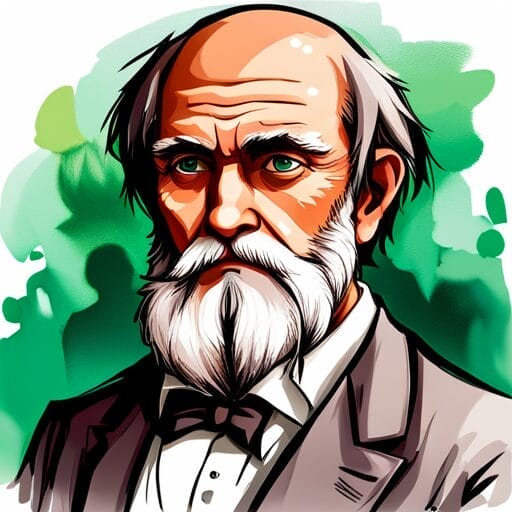Autobiography of Charles Darwin
Early Life and Education
I, Charles Robert Darwin, was born in Shrewsbury, England on February 12, 1809, into a prosperous and intellectually active family. I was the fifth of six children of Robert Darwin, a successful physician, and Susannah Wedgwood, from the well-known pottery family. My grandfathers were renowned individuals in their respective fields: Erasmus Darwin, a physician and poet known for his progressive ideas on evolution, and Josiah Wedgwood, a well-known industrialist and abolitionist.
Despite the loss of my mother when I was just eight years old, I was raised in an environment of encouragement and knowledge. My early education, however, was rather chaotic. I was initially schooled at Shrewsbury before being sent to Edinburgh University in 1825 to study medicine, following in the footsteps of my father and grandfather. Yet, the sight of blood and suffering proved too much for me, and I found the lectures dull, thus turning away from a career in medicine.
A love for natural history led me to Christ’s College, Cambridge in 1828, where I was to prepare to become a clergyman. Though the structured education seemed unnecessary at the time, the bachelor’s degree in theology I earned in 1831 opened the doors to my future.
The Voyage of the Beagle
Opportunity presented itself in the form of an unpaid naturalist position aboard the HMS Beagle. The ship, under the command of Captain Robert FitzRoy, was to embark on a five-year survey expedition around the world. Intrigued by the idea of observing the natural world and collecting specimens, I set out on what would be a formative voyage on December 27, 1831.
The voyage, though often difficult with long periods at sea, exposed me to a stunning array of biodiversity and geographic phenomena. I collected fossils, studied local inhabitants and their cultures, and began to form theories about the interconnectedness of life.
The Galapagos Islands, visited in September 1835, were particularly influential. Observing the local fauna, especially the different species of finches, I noted the differences that seemed to correlate with the environments of their respective islands. Such observations laid the groundwork for the development of my most well-known theory.
Developing the Theory of Evolution
After the Beagle returned to England in 1836, I began sorting and cataloguing the plethora of specimens collected during the voyage. Over time, patterns began to emerge that contradicted the conventional understanding of the immutability of species.
I mulled over these ideas and, in 1838, while reading Thomas Malthus’s work on population dynamics, I realised that the same struggle for existence that Malthus described among humans could apply to all life forms. This led to the formulation of the theory of natural selection, where those individuals best adapted to their environment have a higher chance of surviving and reproducing. This process, over vast timescales, could lead to the formation of new species.
However, I held back these radical ideas from the public for almost two decades due to their potential to stir controversy. It was only when fellow naturalist Alfred Russel Wallace independently arrived at a similar theory of natural selection that I was prompted to go public.
The Origin of Species and Its Aftermath
In 1859, I published “On the Origin of Species by Means of Natural Selection”, a book that compiled my observations and proposed the theory of evolution through natural selection. While the book was widely read and sold out on the first day, it ignited controversy, especially among religious groups who believed in the immutability of species as per biblical accounts.
The theory proposed in the Origin was met with both support and criticism. Nonetheless, it sparked widespread debate and gradually won increasing acceptance in the scientific community.
In the years that followed, I continued to expand on my theories, publishing works like “The Descent of Man” (1871) and “The Expression of the Emotions in Man and Animals” (1872), contributing further to areas like human evolution and behavioural sciences.
Personal Life and Later Years
In 1839, I married my first cousin, Emma Wedgwood, and we moved to Down House, Kent. We were blessed with ten children, though sadly, three did not survive into adulthood. My health, which had always been fragile, worsened over the years, though it never curbed my enthusiasm for research and writing.
My last years were spent continuing my research and writing, as well as enjoying the company of my family. I passed away on April 19, 1882, leaving behind a legacy in the field of natural sciences that persists to this day.
Looking back, my life has been a journey of curiosity, discovery, and understanding the intricate tapestry of life. As the architect of the theory of evolution, my work fundamentally transformed our understanding of the natural world and our place within it. Yet, I remain a humble naturalist, who took joy in the wonders of the world around him. It is my hope that future generations will continue this exploration with the same sense of wonder and dedication.
Show more +
